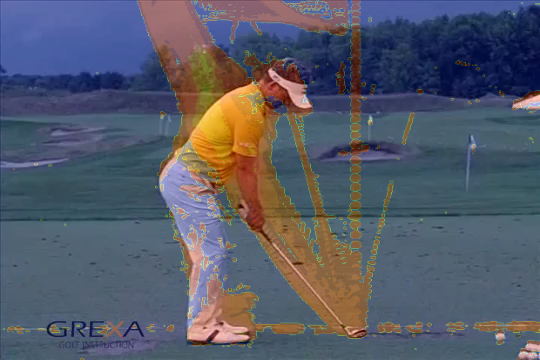Entry 2¶

Authors¶
- Tony Perkins
We had some simple fixed camera video footage which we wanted to do some sort of motion tracking analysis on. I used OpenCV to compare sequential frames. By simply taking the absolute difference with a threshold, frame-by-frame motion tracking is obtained. This motion tracking data which was allowed to accumulate as we advance through the video. The resulting dataset was graphed as a filled contour plot. The borders of the graph where removed, the result resized, and overlaid over the opening frame of the video. This final image makes for a very effective visualization of the video motion.
Products¶
Source¶
__author__ = 'tony'
import cv2
import numpy as np
import matplotlib.pyplot as plt
def _get_motion_detection_frame(previous_frame, current_frame):
d1 = cv2.absdiff(current_frame, previous_frame)
# increase THRESH for filtering more out
THRESH = 15
cv2.threshold(d1, THRESH, 255, cv2.THRESH_BINARY, dst=d1)
return d1
if __name__ == '__main__':
cap = cv2.VideoCapture('Luke Donald - slow motion golf swing.mp4')
num_frames_read = 0
success, frame = cap.read()
cv2.imwrite('opening_frame.png', frame)
while success:
num_frames_read += 1
current_frame = cv2.cvtColor(frame, cv2.COLOR_BGR2GRAY)
'''
Blurring the data removes some camera wiggle from showing up in the motion detection.
Add more blur if you have lots of shakey cam.
'''
current_frame = cv2.GaussianBlur(current_frame, (5, 5), 0)
if num_frames_read == 1:
previous_frame = current_frame
elif num_frames_read == 2:
mdf = _get_motion_detection_frame(previous_frame, current_frame)
else:
mdf += _get_motion_detection_frame(previous_frame, current_frame)
previous_frame = current_frame
success, frame = cap.read()
# If you want to set which frames are used.
if num_frames_read == 3000:
success = False
heat_data = mdf[::-1, :]
x, y = heat_data.shape
x,y = np.mgrid[0:x, 0:y]
f = heat_data[x, y]
fig = plt.figure()
plt.contourf(f, 10)
ax = plt.subplot(111)
ax.spines["top"].set_visible(False)
ax.spines["bottom"].set_visible(False)
ax.spines["left"].set_visible(False)
ax.spines["right"].set_visible(False)
plt.tick_params(axis="both", which="both", bottom="off", top="off",
labelbottom="off", left="off", right="off", labelleft="off")
fig.savefig('heatmap.png', pad_inches=0.0, bbox_inches="tight")
cap.release()
cv2.destroyAllWindows()
hot_img = cv2.imread('heatmap.png')
open_img = cv2.imread('opening_frame.png')
x, y, z = open_img.shape
big_hot_img = cv2.resize(hot_img, (y, x), interpolation=cv2.INTER_LINEAR)
opacity = 0.3
result_img = big_hot_img*opacity+open_img*(1-opacity)
cv2.imwrite('final_image.png', result_img)